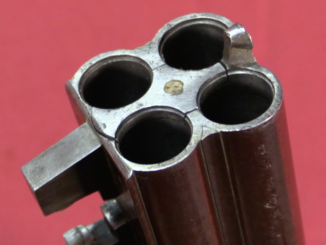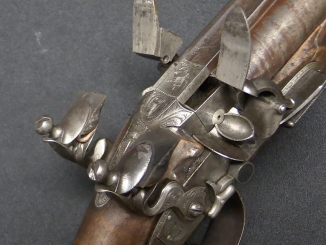Patented in 1868 by Colonel G.H. Money and Mr. M. Walker, this rifle was one of the 10 finalists in the British breechloading rifle trials of 1868. It is a simple falling block system with an internal hammer. In the second set of trials, it proved to be middle of the pack in rapidity of fire (20 shots in 1 minute and 14 seconds) but succumbed badly to exposure testing. The Martini would win those trials, and the Money-Walker system was only used in limited commercial rifle and shotgun manufacture.
Related Articles

Light MGs
Hefah Machine Gun
The Hefah machine gun was a wartime expedient British light machine gun design. It was created by a private company (the Ductile Steel Company) in 1940, in response to a generalized concern that all LMG […]

Shotgun
Lancaster Four-Barrel Shotgun With Double-Action Trigger
Charles Lancaster started his unmaking business in London in 1826, and it would survive more than one hundred years, being run after Charles’ death by his sons and then by an apprentice who bought out […]

Antiques
Manton’s Waterproof Flintlock
How does one keep a flintlock action reliable in wet, riany weather? Well, let’s have a look at a flintlock shotgun designed specifically to be waterproof! This is a Joseph Manton shotgun from about 1815. […]

That’s a delightfully simple system.
A few years back, Ian showed a French double barrel shotgun, with what appeared to have a very similar action to the Money-walker.
Interesting attempt. But against Martini, he did not have a single chance in all nominations.
I suspect that it also stuffed the base of the thumb with this tail…
PS In all except the rate of fire.
Interestingly, it seems to me alone that this tail will not allow to tightly cover the waist at all?
Very nice rifle, I’d love to see some of the sporting versions, especially the doubles they apparently made, but I doubt there are more than a handful left, and probably none in North America
The action lever reminds me a bit of the Westley Richards ‘monkey tail’ paper cartridge breechloader, a direct descendant of which I believe competed against this rifle in the trial